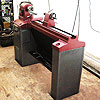Hi everyone it's been a while but I need some help. I'm trying to finish my vacuum chucks for small boxes and I decided to use wooden plates to hold the chuck cylinder. I started with maple using a tap purchased for the job I also am using a tap guide and a paddle bit 1/8" smaller than my 1 1/4" tap. Here are the issues I'm facing:
- First, the paddle bit (used on my drill press seems to make less than the perfect sized hole. I finally changed to an old adjustable wood bit and get a cleaner cut but still wonder why the paddle isn't working as well
- Second, The tap seems to cut away the threads as it is making them. I have tapped metal for many years and had no problems but the wood doesn't seem to react the same. Is it wood type, grain direction or what.
Any help would be appreciated.Thanks. By the way Merry Christmas and a Happy New Year to all.







 Reply With Quote
Reply With Quote







